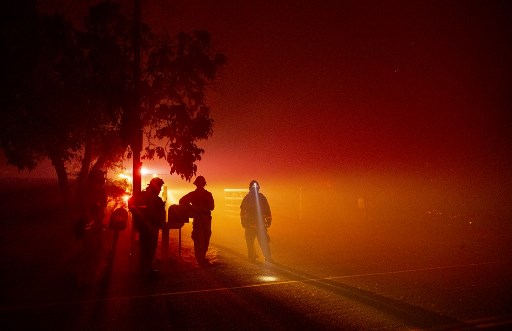
At least 22 large fires are burning in California, where dry, windy conditions and record-breaking high temperatures have been fueling flames for weeks in some areas.
While firefighters continue to battle the flames and rescue people from dangerous areas, other agencies are proactively closing national forests and temporary power shut-offs have been ordered to prevent future blazes.
A public safety power shutoff is in effect for 22 counties in Northern California, with 172,000 Pacific Gas and Electric (PG&E) customers impacted Monday night. Full restoration of power is expected by Wednesday evening.
There are currently 76 large wildfires burning across the United States, according to the National Interagency Fire Center, but California has remained the hardest hit state. Of the more than 5,500,000 acres that have been burned nationwide so far this year, California accounts for more than 2,000,000 acres scorched, NIFC said.
A red flag warning has been issued by the National Weather Service for Ventura and Los Angeles counties through Wednesday morning.
Peak wind gusts of up to 50 mph are expected for many elevated areas in Northern California, which only exacerbates an already active fire season in the state as hot and dry weather will continue to dry out vegetation and make it more susceptible to fires during a wind event, PG&E Senior Meteorologist Scott Strenfel explained.
“Unfortunately, this wind event is occurring on the heels of the current heat wave and will produce critical fire potential conditions,” Strenfel said.
“Windy conditions, like those being forecast, increase the potential for damage and hazards to the electric infrastructure, which could cause sparks if lines are energized. These conditions also increase the potential for rapid fire spread,” PG&E said in a news release on Monday.
Hundreds rescued from Creek Fire
The fast moving Creek Fire in the Sierra National Forest has grown to 135,523 acres and has no containment, US Forest Service Supervisor Dean Gould said during a Monday night press briefing.
Gould called the fire an “unprecedented disaster” for Fresno County, adding that while major wildfires have occurred in the area before, the Creek Fire is the “most aggressive of any of those.”
“This one's in a class by itself,” Gould added.
The “massive” wildfire has caused heavy structural damage and current conditions are preventing damage inspection teams from getting into the areas to survey exactly how many structures have been lost, a Cal Fire official said during the briefing.
As the fire continues to spread, blocking roads and trails, evacuations have been ordered in Madera and Fresno counties. Many people on vacation for the holiday weekend have become trapped and required aerial rescues.
Throughout the day, helicopters have been attempting to rescue those who are trapped by the fire. This remains a high priority, Fresno County Sheriff's Deputy Lieutenant Brandon Pursell said.
According to Pursell, there are temporary areas of refuge in four different locations.
“Those people that are in those temporary areas of refuge are safe,” Pursell said. “We want the families to understand that those people are safe.”
A rescue operation was underway for about fifty people trapped by the fire near Lake Edison and China Peak late Monday night, according to tweets from Fresno Fire.
The first attempt was unsuccessful due to heavy smoke conditions, but the Chinook helicopter will make other attempts using night vision, Fresno Fire said.
Over the weekend, more than 200 people were rescued from the area as flames surrounded Lake Mammoth Reservoir.
Fire threat closes National Forests
Another safety measure due to the “monumental fire threat” is the closure of National Forests in Southern and Central California.
Statewide, all campgrounds will be closed for both day use and overnight camping starting Monday night, a press release from the US Forest Service said.
“Most of California remains under the threat of unprecedented and dangerous fire conditions with a combination of extreme heat, significant wind events, dry conditions, and firefighting resources that are stretched to the limit,” the release said.
Among the areas being closed are the Sierra National Forest, where the Creek Fire is still burning out of control and The San Bernardino National Forest, where the El Dorado Fire was sparked by a device at a gender reveal party. Sequoia National Forest will be closed as well, but the National Park remains open with restrictions of no fires, and a warning of poor air quality.
The closure means no hiking, biking, fishing, or even taking scenic drives. The Forest Service hopes the closure will reduce the potential for fires caused by humans.
“The wildfire situation throughout California is dangerous and must be taken seriously.
Existing fires are displaying extreme fire behavior, new fire starts are likely, weather conditions are worsening, and we simply do not have enough resources to fully fight and contain every fire,” said Randy Moore, Regional Forester for the USDA Forest Service Pacific Southwest Region.
The full closures impact Stanislaus National Forest, Sierra National Forest, Sequoia National Forest, Inyo National Forest, Los Padres National Forest, Angeles National Forest, San Bernardino National Forest, and Cleveland National Forest. They will be re-evaluated daily as conditions change.
Despite how large and widespread the fires in the US are, this season is actually lower than the 10-year average for the same period, according to NIFC. So far this year, there have been a total of 40,883 fires, a number below the 10-year average of 43,456, according to the data from NIFC. The total acreage burned since the beginning of the year is 4,645,058, compared to the 10-year average of 5,680,220 acres, the NIFC said.




